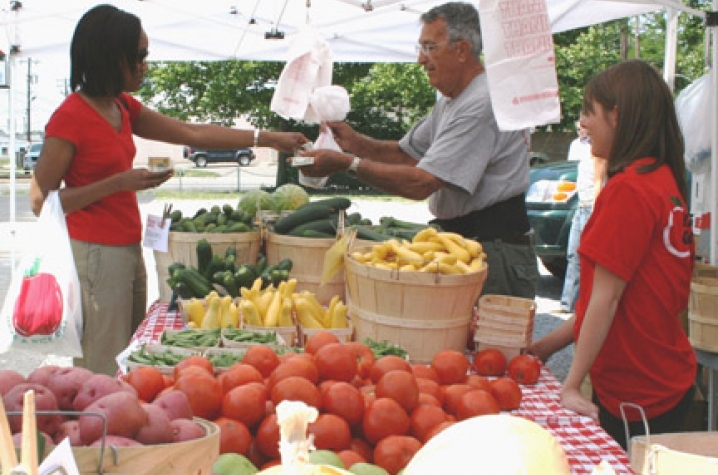Ag Study Finds Strong Growth in Kentucky Produce

LEXINGTON, Ky. (Aug. 16, 2012) — The state’s produce industry continues to expand in terms of producers, volume, marketing outlets and sales, which are likely to exceed a record-breaking $33 million in 2012. That is what a new study from the University of Kentucky College of Agriculture has found.
“In terms of some of the production and marketing activity, produce seemed to take a little bit of a backseat (for awhile), but now it seems to be going through a renaissance,” said Tim Woods, agricultural economics extension professor and the principal investigator on the “2012 Kentucky Produce Planting and Marketing Intentions Grower Survey and Outlook.”
Kentucky’s produce sector was boosted from 1997 to 2007 by the formation of several produce cooperatives, seeing an increase in sales from $10.4 million in 1997 to $24.025 million in 2007, accounting for 2.6 percent of gross farm sales that year. By 2008, however, most produce co-ops in the state had closed their doors. Only 13 of the 294 who responded to the survey used a co-op in 2011 to sell their produce. Much of that wholesale activity, instead, has moved through private wholesale associations, auctions and individual producer wholesale arrangements.
Kentucky producers continue to rely substantially on direct markets, with 41.2 percent of survey responders indicating they sell more than 10 percent of their product through farmers markets and 40.5 percent selling at least 10 percent through on-farm markets.
Between 1998 and 2012, the number of community farmers markets in the state has increased from 40 to 151. The survey found that farmers market gross sales account for about 25 percent of the industry’s gross sales. Woods and the study’s other authors, Matt Ernst and Kevin Heidemann, found that recent sales data from selected farmers markets around the state suggest gross sales in the $10 to $12 million range.
Producers seem to be diversifying into more market channels. The survey shows that the percentage of survey respondents who sell all their produce through a farmers market has declined since 2006. That year, 18 percent sold through farmers markets, while levels for 2011 dropped to 7.5 percent. The survey’s authors believe that vendors branching into multiple direct-market channels, such as on-farm sales, Community Supported Agriculture sales and direct sales to restaurants and grocery stores, accounts for this drop.
Woods observes continued rapid growth in produce auctions. There are now produce auctions in Bath, Henry, Casey, Christian, Hart and Lincoln counties. The Fairview Market in Christian County, Kentucky’s largest produce auction, has been in business since 1998 when the local Mennonite community established it.
“Amish and Mennonite communities are moving in with significant investments, both in capital and acreage, and really driving a lot of the growth, particularly in the auctions,” Woods said.
More than 17 percent of the survey’s respondents indicated they’d sold more than 10 percent of their crops in 2011 through produce auctions. That is the highest percentage of respondents since the survey was initiated in 2001. The survey’s authors predict that auctions, as a group, will generate $5 to $7 million in produce sales in 2012.
MarketReady and the Kentucky Department of Agriculture’s Restaurant Rewards programs have helped to boost direct sales to restaurants and grocery stores, by providing growers with marketing training and tools, and providing financial incentives to both food outlets and producers.
“It’s largely a demand-driven phenomenon we’re seeing out there—a huge growth in demand for local products,” Woods said. “We’re seeing it in groceries, restaurants, in the community farm markets and on-farm agritourism communities; those, especially, have really taken off.”
Producers indicated they are optimistic about continued sales growth. The survey found that sales expansion projected by growers three years ago seems to have played out as expected. There is every reason to believe that a similar growth trend willcontinue over the next three years.
Though the state’s produce industry continues to be dominated by producers who reported making less than $50,000 in gross sales, Woods sees a future where commercial horticulture could be a larger part of Kentucky’s agricultural economy.
“I think we’ll see that eventually, due in part to our proximity to some bigger markets,” he said. “It’s really striking to see the growth and the value of both fruits and vegetables in Kentucky relative to our neighbors in the region.”
The link to the complete “2012 Kentucky Produce Planting and Marketing Intentions Grower Survey and Outlook” can be found on UK Ag’s Crop Diversification and Biofuel Research and Education Center’s website, http://www.uky.edu/Ag/NewCrops/.
MEDIA CONTACT: Carol Spence, 859-257-8324




